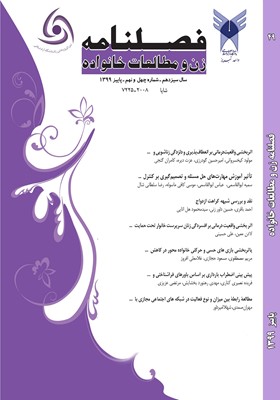اثربخشی واقعیتدرمانی بر انعطافپذیری و دلزدگی زناشویی و تعهداجتماعی در زوجین متقاضی طلاق شهرستان ملایر
محورهای موضوعی : زن و خانوادهامیرحسین گودرزی 1 , مولود کیخسروانی 2 , عزت دیره 3 , کامران گنجی 4
1 - دانشجوی دکتری روانشناسی، واحد بوشهر، دانشگاه آزاد اسلامی، بوشهر، ایران.
2 - استادیار گروه روانشناسی، واحد بوشهر، دانشگاه آزاد اسلامی، بوشهر، ایران (نویسندۀ مسئول).
moloud.keykhosrovani@gmail.com
3 - استادیار گروه روانشناسی، واحد بوشهر، دانشگاه آزاد اسلامی، بوشهر، ایران.
4 - دانشیار گروه روانشناسی، واحد ملایر، دانشگاه آزاد اسلامی، ملایر، ایران.
کلید واژه: واقعیت درمانی, تعهد اجتماعی, دلزدگی زناشویی, انعطافپذیری زناشویی,
چکیده مقاله :
هدف از پژوهش حاضر بررسی تاثیر واقعیت درمانی مبتنی بر نظریه انتخاب بر انعطافپذیری زناشویی، دلزدگی زناشویی و تعهداجتماعی زوجین متقاضی طلاق بود.روش پژوهش نیمه آزمایشی با طرح پیش آزمون- پس آزمون با گروه کنترل بود. جامعه آماری پژوهش را کلّیه ی زوجهای متقاضی طلاق شهر ملایر درسال 1398 تشکیل میدادند که با روش نمونه گیری دردسترس 30 زوج انتخاب گردیده و به طور تصادفی در دوﮔﺮوه آزمایش و کنترل جایگزین شدند. برای جمع آوری داده ها از پرسشنامه ها ی دلزدگی زناشویی پاینز (2003)، پرسشنامه ی انعطاف پذیری شناختی دنیس و وندروال (2010) و پرسشنامه تعهد اجتماعی آدامز و جونز (1997) استفاده شد. داده ها از طریق آزمون آماری کوواریانس چندمتغیری مورد تجزیه و تحلیل قرار گرفتند. نتایج حاصل از یافته های توصیفی نشان داد که بین دو گروه آزمایش و کنترل در پیش آزمون و پس آزمون تفاوت معناداری وجود دارد و نتایج حاصل از یافته های استنباطی نیز نشان داد که در متغیر انعطافپذیری شناختی بین گروه کنترل و آزمایش تفاوت معناداری وجود دارد(05/0 p < ). در متغیر دلزدگی زناشویی نیز، در مرحله پسآزمون تفاوت معناداری بین گروه آزمایش و کنترل وجود دارد (05/0 p < )؛ در متغیر تعهد اجتماعی نیز مشاهده میشود که بین گروه آزمایش و کنترل در مرحله پسآزمون و پیگیری تعهد اجتماعی تفاوت معناداری وجود دارد (05/0 p < ). براین اساس می توان بیان نمود که مداخله واقعیت درمانی مبتنی بر نظریه انتخاب بر مولفه های انعطاف پذیری، دلزدگی و تعهد اجتماعی در زوجین متقاضی طلاق موثر بوده و می توان از این نوع مداخله در مشاوره و درمان زوجی به ویژه زوجین دارای تعارض استفاده نمود.
The aim of the present study was to investigate the effect of reality-therapy based on choice theory on marital flexibility, marital boredom and social commitment of couples seeking divorce. The research method was quasi-experimental with pre-test-post-test design Including a control group < /p> control group. The statistical population of the study Consisted of the total number of couples applying for divorce in Malayer in 1398. From among that population, 30 couples were selected as the sample of the study based on available sampling design and were randomly Assigned into two groups of experimental and control. in two experiments and control. The Painz (2003) Marital Boredom Questionnaire, Dennis & Wendrew's Cognitive Flexibility Questionnaire (2010), and the Adams and Jones Social Commitment Questionnaire (1997) were used to collect data. Data were analyzed by multivariate covariance statistical test. The results of the descriptive findings showed that there was a significant difference between the experimental and control groups Please check this and the results of the inferential findings showed that there was a Significant difference in the cognitive flexibility variable between the control and experimental groups (P <0.05). In the marital boredom variable, there is a significant difference between the experimental and control groups in the posttest stage (P <0.05); But in the follow-up phase, there is no significant difference between the experimental and control groups in marital boredom (P <0.05). In the social commitment variable, it is also observed that there is a significant difference between the experimental and control groups in the post-test phase (5.45) and follow-up (10.28) of the social commitment (P <0.05). Based on Based on the findings , it can be stated that the intervention of reality therapy based on the theory of choice on the components of flexibility, boredom and social commitment in couples seeking divorce is effective and this type of intervention can be used in counseling and couple therapy.


